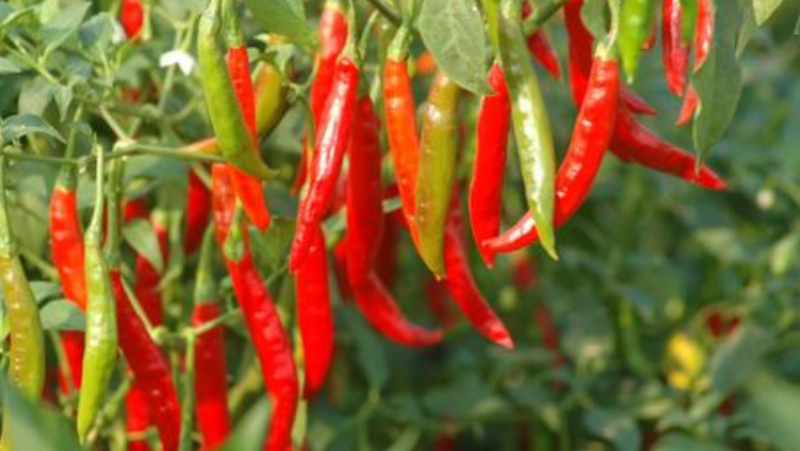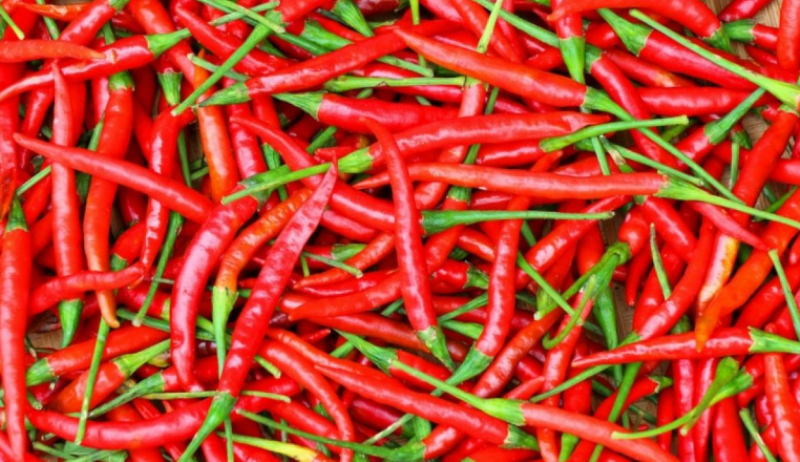
Chilli is a spicy fruit used in cuisine preparations. It is mostly added as an ingredient in foods to make it spicy. As per the latest data, India tops the list in chilli production followed by China, Peru, Spain and Mexico. Indian chillies are known for their pungency and color, especially the ones grown in Guntur district of Andhra Pradesh. Some of the chillies that are bigger in size are called bell peppers and are used as a vegetable. Chilli has various local names in India like lanka, mirchi etc.
Ideal Conditions for Chilli Cultivation
Climatic Requirements
Chilli is a tropical and sub-tropical plant requiring a combination of warm, humid yet dry weather. During the growth stage it needs a warm and humid weather. However, a dry weather is suitable for fruit maturity. Range between 20⁰-25⁰C is ideal temperature range for chilli growth. At 37⁰C or higher the crop development is affected. Similarly in case of heavy rain the plant starts rotting. In case of low moisture conditions during fruiting time period the bud does not develop properly. Hence, flower and fruit may drop off. It means that, a high temperature and relatively low humidity level would lead to deflowering and fruits if developed would be very small.
Soil for Chilli Cultivation
Chillies need moisture for growth. It has been found that black soil which retains moisture is ideal in case they are grown as rainfed crops. Under irrigated conditions, the crop needs well-drained sandy loam with rich organic content. They can also be grown in deltaic soil under irrigated conditions. In areas such as Uttarakhand, soil is mixed with gravel and coarse sand before undertaking chilli cultivation.
pH Requirement
pH of soil should be between 6.5 and 7.5 (neutral soil). It cannot tolrate acidic nor alkaline soil.
In which Season Chilli Farming Should be done
Chillies can be grown both as Kharif and Rabi crop. In addition they are also planted at other times. Sowing months are May to June for Kharif crop, September to October for Rabi crops. If they are grown as summer crops then January-February months are chosen.

Water for Green Chilli Cultivation
Chillies are crops that cannot resist a lot of water. Heavy rainfall and stagnated water would result in rotting of the plants. In case of irrigated crops, watering should be only when it is necessary. A frequent watering would result in shedding of flowers and a spurt of vegetative growth. The amount of water to be irrigated, the number of irrigations and its frequency highly depends on the climatic conditions and the soil type. If the leaves start drooping during day time it is an indication of water requirement. If the flowers are weak then irrigating the crop would be helpful. Some farmers irrigate the field once the soil moisture content falls below 25%.
Want Planting Material for Chilli Plantation
Chillies are propagated from seeds. At the time of cultivation, disease- free, good quality seeds must be chosen. Various high yielding, disease resistant varieties have been developed by research institutes and different organizations. In case of organic farming, they must be obtained from farms certified by the central authority.
Chilli Varieties
Jwala
-
Highly pungent variety with small
-
The fruits have a red color.
-
They are harvested from September to December.
-
It is Grown in parts of Gujarat.
Kanthari
-
Fruits are short with high level of pungency.
-
Color is ivory-white.
-
Grown as a homestead crop, they are available all year round.
-
Grown in Kerala and parts of Tamil Nadu.
Kashmiri Chilli
-
Fruits are long and have a deep red color.
-
They are harvested from November to February months.
-
These are grown in North Indian states like Jammu-Kashmir and Himachal Pradesh.
Bhagya Lakshmi
-
It is also known as G-4 this variety is grown in irrigated areas of Andhra Pradesh.
-
The fruits are olive green in colour, which turns dark red when ripe.
-
The variety is tolerant towards pests and diseases.
TNAU Hybrid Chilli Co1
-
Developed by TNAU, Coimbatore the fruits are 12 cm long.
-
The raw fruits are light green in color and tapering at the tip.
-
Moderately resistant to fruit rot.
-
Yields 11 tonnes per acre of green chilli and 2 tonnes of dry pods per acre.
-
These Chillies are ready for harvest within 200 days of plantation.
KI
-
It is developed through pure line selection from Assam typeB72A.
-
They are suitable for cultivation in rainfed areas.
-
Plants are tall with fruits spread out.
-
Yields about 700 Kg of fruits per acre.
PLR1
-
This variety is from Kandangadu type chillies.
-
The fruits are medium-sized with a bulging base.
-
The tip is dull and the chillies appear glossy.
-
It is most widely used for pickling purposes using buttermilk.
-
These crops are ready to be harvested within 210 days and they yield around 7 tonnes per acre.

Land Preparation for Chilli Cultivation
The land needed for chillies farming are ploughed 2-3 times and brought to a fine tilth. The gravel, stones and other such unwanted material present in the soil are removed. If the seeds are sown directly in the soil then it is carried out along with the last ploughing cycle. However, at the time of ploughing, the soil must be sterilized properly so that diseases affecting the plants are kept in check.
Soil Treatment for Organic Farming
-
The soil is treated with Azotobacter or AzospirillumIf, if chillies are being planted in an organic farm.
-
Around 1 Kg of Azotobacter or Azospirillum is mixed with 50 Kg of farm yard manure.
-
We can also add 2 tonnes of vermicompost is added on per acre basis.
Soil Treatment for Conventional Farming
-
In case of conventional farming, soil sterilization is done with the help of
-
Around 20 mL of formalin is mixed with a liter of water before applying on soil.
-
After applying, it is covered with polyethylene sheet of 25 micron thickness for 1-1.5 days.
-
For 15 days, they are aerated.
-
Around 8-10 Aldrin per acre is applied to the soil, during the time of last ploughing. This protect crop from pests like white ants.
-
Ridges and furrows are dug with a spacing of 60 x 45 cm and 75 x 60 cm for hybrids.
-
Raised beds are built at a distance of 30 cm from each other and are 120 cm wide.
Sowing Chilli or Mirchi Plant
Seed Treatment
-
This is first steps on sowing.
-
Chilli seeds are never ever pre-treated with chemicals, instead they are treated with herbal fungicides.
-
Around 80 grams of seeds are required for sowing in one acre of land.
-
The seeds are treated with Pseudomonas fluorescens. It is a bio-fungicide which protects the crop from fungal attacks and pests.
-
The seeds are then mixed with Azospirillum and for half hour they are shade dried.
Chilli seedlings in nursery
-
The seeds of chilli are commonly grown in nurseries and then the seedlings are transplanted.
-
After sowing the seeds are covered with coco peat and it is watered everyday till it germinates.
-
Around 3% Panchagavya spray is done after 15 days or a micronutrient spray is done after 18 days.
-
Once they are 35 days old, the seedlings are transplanted.
Transplanting
-
For half an hour, the seedlings are dipped in 0.5% Pseudomonas fluorescens solution and then it is transplanted in the main field.
-
The intercrop distance is at 45 cm during plantation.
Intercropping in Chilli Cultivation
-
Chillies are intercropped with onions in rows at some places.
-
It is done in this way that two rows of chillies are followed by one row of onion.
Diseases Management in Chilli Plantation
-
Chillies suffer from a various diseases like anthracnose, fruit rot, dieback, bacterial wilt, mosaic diseases, powdery mildew, leaf spot, etc.
-
Spraying Trichoderma and Pseudomonas species would help prevent disease spread.
Pest Management
-
Pod borers, Thrips, grubs, nematodes, aphids, mites, etc. are the major pests of chilli farming.
-
At the time of farm yard manure application only well-rotted manure is sued.
-
Growing onions with chillies would help prevent pest attack.
Chilli Production per Acre
-
Fresh chilli yield varies from 30-40 quintal per acre.
-
We get 25-35 Kg of dried chilli from 100 Kg of fresh chilli.
-
Average yield of dry chilli varies from 7.5 to 10 quintals per acre.
Harvesting in Chilli Cultivation
-
The harvesting of chilli is done according to the intended use of chillies.
-
For making powdered chilli and dry chilli, fruits are harvested when the chilli turns dark red in color.
-
The green chilli is plucked for preparing pickles.
-
Plucking should be done at regular intervals.
-
Keeping them on the plant for a longer period of time can cause color fading and wrinkles.
-
The chilli in green colour or green chillies can be plucked 8-10 times while ripe ones are plucked 5-6 times.










